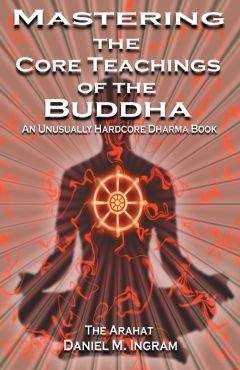Daniel Ingram - Mastering the Core Teachings of Buddha - An Unusually Hardcore Dharma Book
На электронном книжном портале my-library.info можно читать бесплатно книги онлайн без регистрации, в том числе Daniel Ingram - Mastering the Core Teachings of Buddha - An Unusually Hardcore Dharma Book. Жанр: Прочее издательство -, год 2004. В онлайн доступе вы получите полную версию книги с кратким содержанием для ознакомления, сможете читать аннотацию к книге (предисловие), увидеть рецензии тех, кто произведение уже прочитал и их экспертное мнение о прочитанном.
Кроме того, в библиотеке онлайн my-library.info вы найдете много новинок, которые заслуживают вашего внимания.

Daniel Ingram - Mastering the Core Teachings of Buddha - An Unusually Hardcore Dharma Book краткое содержание
Mastering the Core Teachings of Buddha - An Unusually Hardcore Dharma Book читать онлайн бесплатно
135
Concentration vs. Insight
There are many concentration states, and they become progressively more refined as one masters them. A brief description of the concentration states follows. It is basically straight out of the standard texts and very accurate. Regardless of the tradition you are following, when you begin to get some mastery of its concentration practices you will go through these states in this order up to the level of your current ability, though some people can master skipping over jhanas.
The specific object of meditation may limit the level of jhana that can be attained, as well as color the experience of these states. Such details are spelled out in various canonical texts, such as The Vi
suddhimagga and the more readable but harder to find Vim
uttimagga .
Bhante Gunaratana’s The Jhanas, included in his more complete work The Path of Serenity and Insight, is a scholarly work on the subject, as is Nyanatiloka’s Path to Deliverance (published by the Buddhist Publication Society out of Sri Lanka).
Some of these texts (particularly the first two) go into long and sophisticated discussions about which posture and which object might be best suited to the individual proclivities of various types of people. It is unfortunate that this sort of information is not in common use today.
I suppose that a suit off the rack will work for most occasions, but there is something about one that has been tailor made. I am told that there are still a few monasteries that provide this sort of traditional training.
Unfortunately, this topic is way too complex to treat properly here, but those of you who are that serious about these subjects are highly advised to check out the original sources. They contain an astounding amount of powerful information but unfortunately make for fairly tedious reading.
Many traditions use the breath as the primary object initially and then shift to the qualities of the states themselves as the object of meditation when they arise and the concentration is strong. The quality of a jhana can either be “soft” or “hard” depending on how solidly one is in the state. In soft jhana, the qualities of that particular state are definitely recognizable in a way that is different from the ordinary experience of those qualities to the degree that we are confident we are in the altered state defined by those qualities.
136
Concentration vs. Insight
In really hard jhana, it feels as if our mind has been fused to those qualities and the object with super glue, as if we were nothing but a solid block or field of those qualities or that object, as if they and the object were the whole world with nothing else remaining. Getting into really
“hard” jhana states dramatically increases the beneficial effects of the practice, though it takes greater strength of concentration and usually requires more favorable practice conditions to do so. Taking the beneficial factors of the jhana solely as the object of concentration is helpful for this, as can be using an easily identified external object such as a candle flame or colored disk.
For detailed instructions in practices that use an external object, called “kasina” practices, the works listed above, particularly Bhante Gunaratana’s The Path of Serenity and Insight, provide such a good treatment of them that you should simply obtain and read those sources. However, the basic instructions are these: stabilize your concentration on an external object (kasina) until you can see the object with your eyes closed or when you are not looking at the object. Take that vision as the new object and stabilize your attention on it until your concentration is like a rock. From this foundation, you should be able to easily attain any of the states I am about to describe.
The basic pattern one goes through with these states is as follows.
First, one develops enough concentration to attain the jhana. Then the mind sees/feels the jhana, moves towards and into it, with almost all such state shifts occurring between the end of the out breath and the beginning of the new in breath, sometimes accompanied by the eyelids flickering. Then there is the honeymoon period, where the jhana is fresh but unsteady. Then there is the maturation period, when the jhana really comes into its own more solidly and shows its true glory. Then the faults of the jhana tend to become noticeable, as well as the proximity of the state to the state below it and the ease of falling into that lower state.
Next, the concentration deepens, and some sort of equanimity about the good and bad aspects of the jhana sets in. When the concentration grows strong enough and the current jhana is no longer desirable, the mind will naturally shift to the next higher jhana and the cycle goes around again within the limits of the humanly attainable states and your current skill level.
137
Concentration vs. Insight
138
Mastering the Core Teachings of the Buddha
21.THE CONCENTRATION STATES (SAMATHA JHANAS)
THE FIRST JHANA
The first jhana arises after the student has gained the ability to actually steady the mind on some object such as the breath, i.e. after a state called “access concentration,” meaning the level of concentration needed to access the first jhana or insight practice. Notice that if we are spinning lost in thought this is basically impossible. If you wish to attain this, I would try to stay as completely as possible with an object for perhaps 1 minute. When you can do this, try for 10 minutes. When you can do this, try for an hour. For instance, if you were using the breath as an object, try to be aware of every single breath at least in part for a full ten minutes, and then for an hour. This is definitely possible, and a reasonable goal. Try not paying too much attention to the individual sensations themselves, but conceptualize the breath as a coherent and continuous entity, with many different types of sensations all being thought of as being the breath. It is important to know that really getting into a sense of the breath as a continuous entity for 10 seconds will do you more good than being generally with the breath on and off for an hour.
Tune into the illusory smoothness of things by purposefully and calmly working with illusions of solidity or fluidity. There is a certain
“into it” quality which helps, sort of like really getting into a slow groove when playing an instrument, having sex, playing a sport, or just sinking into a well-deserved and warm bubble bath. Being in a silent and safe place is very helpful, as is giving yourself permission to relax, put the cares of the world behind you, and enjoy.
If you are using the breath as an object, you might try purposefully visualizing it as sweet, smooth waves or circles that are peaceful and welcome. Try breathing as if you were in a garden of fragrant roses and you wish to experience the fullness of their fragrance. Perhaps these tips will help illustrate the kind of non-resistant and peaceful presence that can help one attain these states. Tune into sensations in and around the primary object that feel good. Harbor no guilt, anxiety or fear related to the depths of pleasure, ease and well-being. The spiritual life need not
The Concentration States (Samatha Jhanas)
be some sort of relentless, austere grind, particularly when doing concentration practices.
As concentration improves, it is as though the mind “sees” the first jhana and grabs on to it. Having an idea of what you are looking for, i.e.
something enjoyable and steady, can be helpful for this. It has the five primary factors of applied and sustained effort or attention, rapture, happiness and concentration. Thus, it is great fun, feels good, but takes consistent effort to sustain. The attention is focused narrowly, as though one were looking at a small area of this page. This state can be quite a relief from the pain and discomfort of sitting meditation and can temporarily quiet the mind somewhat. As with all the concentration states, it is generally quite easy to concentrate on something that is very enjoyable. Thus, one’s concentration skills may improve rapidly and easily after attaining the first jhana and tend to basically flounder until one has attained the first jhana. Thus, attaining the first jhana is really, really important.
People tend to really like this state, and may cling to it for the rest of the retreat if on retreat, or cultivate it again and again in their sitting practice at home. It is a valuable attainment, as it serves as the minimum foundation for both insight and concentration practices. From the first jhana there are basically three things a meditator can do. They can either get stuck there (I know someone who spent some twenty years cultivating the first jhana in their daily practice and thinking this was insight practice), they can progress to the second jhana, or they can
investigate the first jhana and thus begin the progress of insight.
By “investigate” the state, I mean that they can direct their attention to breaking the illusion of the solidity of that state into its component individual sensations so that one can understand their true nature, i.e.
the Three Characteristics, as is done in insight practice with all objects.
Special attention must be paid to trying to experience the precise arising and passing of every individual sensation that makes up the state, particularly the primary beneficial factors of the state listed above.
While it is not actually possible to perceive the arising and passing of every single sensation or to even be mindful of every sensation, it is definitely possible to be clear about enough of them to get enlightened, and that is what matters. It is somewhat common for people to do this 140
The Concentration States (Samatha Jhanas)
half-heartedly and not pay particular attention to the myriad sensations that make up rapture and happiness, as they secretly wish them to be permanent, satisfy and be self or the property of self. Stagnation is basically guaranteed in insight practice if you cling to pleasant sensations in this way, or anything else for that matter. Put another way, if you fail to see the impermanence of objects, you will have artificially solidified them (“clung to” them) and will not gain insight from them.
The near enemy of the first samatha jhana is access concentration, and when the applied and sustained effort or attention flag somewhat, access concentration sets in. As the texts rightly say, the applied and sustained effort, i.e. the fact that you have to make effort to get into and stay in this state, are also somewhat annoying. This becomes more and more apparent, and clear awareness of just this simple fact while staying in the jhana causes the mind to eventually bail out of the first jhana and into the second jhana.
THE SECOND JHANA
The second jhana is like the first, i.e. a seemingly solidified mind state. With the dropping of almost all of applied and sustained effort the rapture and happiness factors created by concentration can really predominate. Thus, whereas the first jhana feels like something you need to pay attention to, the second jhana has the quality of showing itself to you. The focus of attention widens out somewhat, sort of like looking straight ahead without focusing the eyes on anything specific.
Whereas mind-generated objects in the first jhana are stable, they will move (e.g. spin, pulse, resonate, etc.) in the second jhana in ways that correlate with the phase of the breath, moving slowly towards the top and bottom of the breath and more quickly in the middle.
The silence of the mind is noticeably increased, and the pleasure of this state may increase greatly as well, particularly if pleasure is the focus of attention. When this state is really cultivated, the intensity of the pleasure of this state can become pretty much as strong you can stand it.
Again, this state is a fine attainment but can be quite captivating. Some may get stuck cultivating this again and again for some period of time ranging from days to years. Again, the meditator also has the option to try to go on to the third jhana or to investigate this state and begin the 141
The Concentration States (Samatha Jhanas)
progress of insight, paying careful attention to completely deconstructing the state into its moment-to-moment components.
THE THIRD JHANA
If the meditator decides to go on to the third jhana, then just cultivating the second state more deeply and noticing that the rapture or emotional “wow factor” of that state eventually becomes annoying can cause the mind to eventually abandon this state and shift into the third jhana.
In this state, the rapture drops away, and what is left is more cool
“bodily” bliss and equanimity with a lot of mindfulness of what is going on. (It must be noted that it is possible to be so deeply into any jhana, even the first jhana, that the sense of the body is quite vague, distorted or even entirely absent, so this must be kept in mind when reading these descriptions.)
The attention is now in wide focus, sort of like resting in the half of space that is in front of one’s self. The third jhana is like the counterpoint to the focus of attention of the second jhana. In the second jhana, wherever we look we see clearly, whereas in the third jhana the wide periphery of our attention is clear and the center of our attention is murky. This can be extremely confusing until one gets used to it, and trying to stay with one object in the center in the third jhana will cause the meditator to miss what this state has to offer and teach. Moving from the second to the third jhana is like going from focusing on the donut hole to focusing on the outer edge of the donut, except that now you are sitting in the center of the donut. Remember this when you get to descriptions of the Dark Night in the section on the stages of insight, as the Dark Night has as its foundation the third jhana but adds the Three Characteristics. Focusing on the wide periphery is a more inclusive, broader, more sophisticated and complex kind of concentration than the first two jhanas, like going from listening to Elvis to listening to very complex, dissonant Jazz.
In its pure and simple spaciousness, profound clarity, balance and contentment, the third jhana is even better than the second jhana. It is no wonder that people can easily mistake these states for enlightenment, as they can seem to fit the descriptions of what enlightenment might be like. Remember that enlightenment is not a mind state, nor is it 142
The Concentration States (Samatha Jhanas)
dependent on any condition of reality. It does not come and go as these states do.
Again, from this state, the meditator has a few options. They can get stuck, which definitely happens, they can move on to the fourth jhana, or they can investigate this state and begin the progress of insight. This would require extra special attention to make sure that all of the specific sensations that make up peace, equanimity, bliss and spaciousness are clearly observed to arise and pass, not satisfy, and not be self or the property of self.
These qualities are not easy to let go of, and so this can be difficult.
However, upon leaving such a state, the mind will still have a measure of the good qualities of the state. This can be useful to insight practice if one is willing to not cling to such things. This applies to the other states as well, and this is why many teachers have their students master concentration states before they move on to insight practice. On the other hand, such states can be so intoxicating and such a stagnant dead end for those that become fooled by them that some teachers have their students avoid them like the plague until they have some very deep insights into the truth of things.
Похожие книги на "Mastering the Core Teachings of Buddha - An Unusually Hardcore Dharma Book", Daniel Ingram
Daniel Ingram читать все книги автора по порядку
Daniel Ingram - все книги автора в одном месте читать по порядку полные версии на сайте онлайн библиотеки My-Library.Info.




